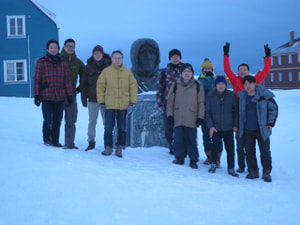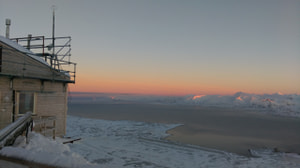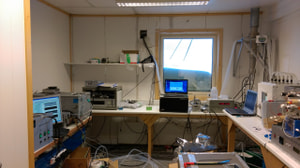We have just started an intensive observation campaign Arctic Clouds, Aerosols, and Radiation Experiment 2017(Arctic-CARE 2017)in Ny-Alesund in Norway. The Arctic is warming more rapidly than the rest of the globe, but the contributions from forcing and feedback mechanisms associated with aerosols and clouds remain uncertain. In this campaign, a research group consisting of National Institute of Polar Research, the University of Tokyo, and the West Texas A&M University is making intensive measurements of the aerosols and clouds at Mt. Zeppelin observatory (474 m a.s.l.) in Ny-Alesund.
The team of the University of Tokyo, which I belong to, has installed a novel instrument that enables quantification of black carbon (BC) content within the individual aerosol particles with a variety of chemical compositions. BC is a dark-colored carbonaceous aerosol (soot particle) and generated during the combustion process of fossil fuel or biomass. BC transported from mid- and high-latitudes to the Arctic region strongly absorbs the solar radiation and may accelerate the warming of the Arctic. We accurately measure the BC abundance, size distribution, and mixing states with other aerosols, which will be the basis for assessing the climate impacts of BC in the Arctic.
We have also installed a new cloud probe at the observatory. When the observatory is in a cloud, this instrument takes high-resolution pictures of individual cloud particles and provides their number size distributions. Although it has been reported that mixed phase clouds persistently appear in the Arctic lower troposphere, the mechanism of their persistency and number concentrations of ice nucleating particles are quite uncertain. We obtain the basic, statistical data of cloud particles at Mt. Zeppelin and aim to elucidate the aerosol-mixed phase cloud interaction.
The installation of these instruments as well as those of other ArCS teams at Mt. Zeppelin were tough work because of the severe conditions of the observatory in winter. We could start our measurements successfully and we would like to thank strong supports and help by the Norway Polar Institute, which is operating the Mt. Zeppelin observatory. I am looking forward to seeing interesting data that will be obtained from now on.
Sho Ohata (The University of Tokyo)
 Observation members at the beginning of the campaign
Observation members at the beginning of the campaign
 View from the Mt. Zeppelin observatory
View from the Mt. Zeppelin observatory






